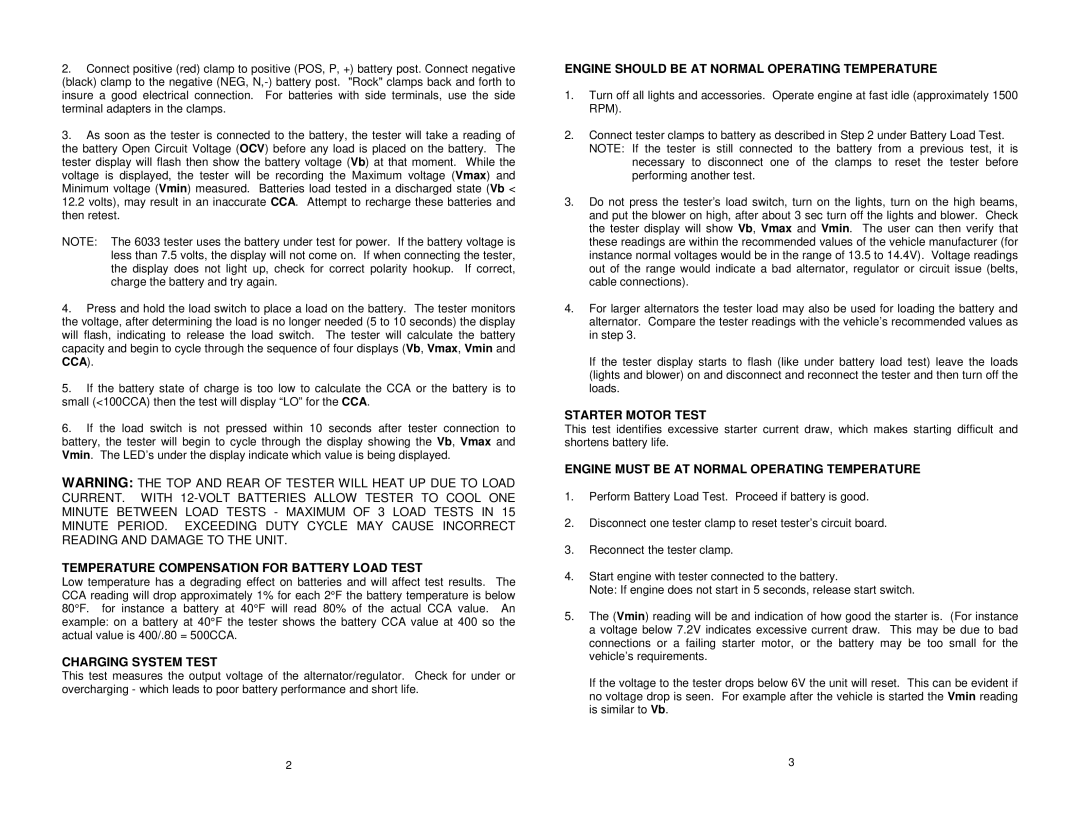2.Connect positive (red) clamp to positive (POS, P, +) battery post. Connect negative (black) clamp to the negative (NEG,
3.As soon as the tester is connected to the battery, the tester will take a reading of the battery Open Circuit Voltage (OCV) before any load is placed on the battery. The tester display will flash then show the battery voltage (Vb) at that moment. While the voltage is displayed, the tester will be recording the Maximum voltage (Vmax) and Minimum voltage (Vmin) measured. Batteries load tested in a discharged state (Vb < 12.2 volts), may result in an inaccurate CCA. Attempt to recharge these batteries and then retest.
NOTE: The 6033 tester uses the battery under test for power. If the battery voltage is less than 7.5 volts, the display will not come on. If when connecting the tester, the display does not light up, check for correct polarity hookup. If correct, charge the battery and try again.
4.Press and hold the load switch to place a load on the battery. The tester monitors the voltage, after determining the load is no longer needed (5 to 10 seconds) the display will flash, indicating to release the load switch. The tester will calculate the battery capacity and begin to cycle through the sequence of four displays (Vb, Vmax, Vmin and CCA).
5.If the battery state of charge is too low to calculate the CCA or the battery is to small (<100CCA) then the test will display “LO” for the CCA.
6.If the load switch is not pressed within 10 seconds after tester connection to battery, the tester will begin to cycle through the display showing the Vb, Vmax and Vmin. The LED’s under the display indicate which value is being displayed.
WARNING: THE TOP AND REAR OF TESTER WILL HEAT UP DUE TO LOAD CURRENT. WITH
TEMPERATURE COMPENSATION FOR BATTERY LOAD TEST
Low temperature has a degrading effect on batteries and will affect test results. The CCA reading will drop approximately 1% for each 2°F the battery temperature is below 80°F. for instance a battery at 40°F will read 80% of the actual CCA value. An example: on a battery at 40°F the tester shows the battery CCA value at 400 so the actual value is 400/.80 = 500CCA.
CHARGING SYSTEM TEST
This test measures the output voltage of the alternator/regulator. Check for under or overcharging - which leads to poor battery performance and short life.
ENGINE SHOULD BE AT NORMAL OPERATING TEMPERATURE
1.Turn off all lights and accessories. Operate engine at fast idle (approximately 1500 RPM).
2.Connect tester clamps to battery as described in Step 2 under Battery Load Test. NOTE: If the tester is still connected to the battery from a previous test, it is
necessary to disconnect one of the clamps to reset the tester before performing another test.
3.Do not press the tester’s load switch, turn on the lights, turn on the high beams, and put the blower on high, after about 3 sec turn off the lights and blower. Check the tester display will show Vb, Vmax and Vmin. The user can then verify that these readings are within the recommended values of the vehicle manufacturer (for instance normal voltages would be in the range of 13.5 to 14.4V). Voltage readings out of the range would indicate a bad alternator, regulator or circuit issue (belts, cable connections).
4.For larger alternators the tester load may also be used for loading the battery and alternator. Compare the tester readings with the vehicle’s recommended values as in step 3.
If the tester display starts to flash (like under battery load test) leave the loads (lights and blower) on and disconnect and reconnect the tester and then turn off the loads.
STARTER MOTOR TEST
This test identifies excessive starter current draw, which makes starting difficult and shortens battery life.
ENGINE MUST BE AT NORMAL OPERATING TEMPERATURE
1.Perform Battery Load Test. Proceed if battery is good.
2.Disconnect one tester clamp to reset tester’s circuit board.
3.Reconnect the tester clamp.
4.Start engine with tester connected to the battery.
Note: If engine does not start in 5 seconds, release start switch.
5.The (Vmin) reading will be and indication of how good the starter is. (For instance a voltage below 7.2V indicates excessive current draw. This may be due to bad connections or a failing starter motor, or the battery may be too small for the vehicle’s requirements.
If the voltage to the tester drops below 6V the unit will reset. This can be evident if no voltage drop is seen. For example after the vehicle is started the Vmin reading is similar to Vb.
2 | 3 |
